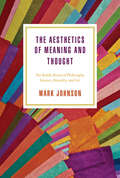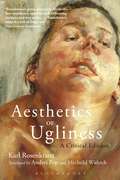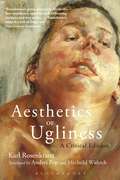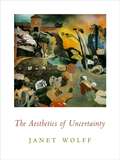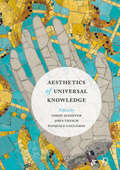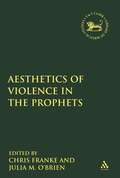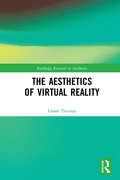- Table View
- List View
The Aesthetics of Meaning and Thought: The Bodily Roots of Philosophy, Science, Morality, and Art
by Mark JohnsonAll too often, we think of our minds and bodies separately. The reality couldn’t be more different: the fundamental fact about our mind is that it is embodied. We have a deep visceral, emotional, and qualitative relationship to the world—and any scientifically and philosophically satisfactory view of the mind must take into account the ways that cognition, meaning, language, action, and values are grounded in and shaped by that embodiment. This book gathers the best of philosopher Mark Johnson’s essays addressing questions of our embodiment as they deal with aesthetics—which, he argues, we need to rethink so that it takes into account the central role of body-based meaning. Viewed that way, the arts can give us profound insights into the processes of meaning making that underlie our conceptual systems and cultural practices. Johnson shows how our embodiment shapes our philosophy, science, morality, and art; what emerges is a view of humans as aesthetic, meaning-making creatures who draw on their deepest physical processes to make sense of the world around them.
The Aesthetics of Meaning and Thought: The Bodily Roots of Philosophy, Science, Morality, and Art
by Mark JohnsonAll too often, we think of our minds and bodies separately. The reality couldn’t be more different: the fundamental fact about our mind is that it is embodied. We have a deep visceral, emotional, and qualitative relationship to the world—and any scientifically and philosophically satisfactory view of the mind must take into account the ways that cognition, meaning, language, action, and values are grounded in and shaped by that embodiment. This book gathers the best of philosopher Mark Johnson’s essays addressing questions of our embodiment as they deal with aesthetics—which, he argues, we need to rethink so that it takes into account the central role of body-based meaning. Viewed that way, the arts can give us profound insights into the processes of meaning making that underlie our conceptual systems and cultural practices. Johnson shows how our embodiment shapes our philosophy, science, morality, and art; what emerges is a view of humans as aesthetic, meaning-making creatures who draw on their deepest physical processes to make sense of the world around them.
The Aesthetics of Meaning and Thought: The Bodily Roots of Philosophy, Science, Morality, and Art
by Mark JohnsonAll too often, we think of our minds and bodies separately. The reality couldn’t be more different: the fundamental fact about our mind is that it is embodied. We have a deep visceral, emotional, and qualitative relationship to the world—and any scientifically and philosophically satisfactory view of the mind must take into account the ways that cognition, meaning, language, action, and values are grounded in and shaped by that embodiment. This book gathers the best of philosopher Mark Johnson’s essays addressing questions of our embodiment as they deal with aesthetics—which, he argues, we need to rethink so that it takes into account the central role of body-based meaning. Viewed that way, the arts can give us profound insights into the processes of meaning making that underlie our conceptual systems and cultural practices. Johnson shows how our embodiment shapes our philosophy, science, morality, and art; what emerges is a view of humans as aesthetic, meaning-making creatures who draw on their deepest physical processes to make sense of the world around them.
The Aesthetics of Meaning and Thought: The Bodily Roots of Philosophy, Science, Morality, and Art
by Mark JohnsonAll too often, we think of our minds and bodies separately. The reality couldn’t be more different: the fundamental fact about our mind is that it is embodied. We have a deep visceral, emotional, and qualitative relationship to the world—and any scientifically and philosophically satisfactory view of the mind must take into account the ways that cognition, meaning, language, action, and values are grounded in and shaped by that embodiment. This book gathers the best of philosopher Mark Johnson’s essays addressing questions of our embodiment as they deal with aesthetics—which, he argues, we need to rethink so that it takes into account the central role of body-based meaning. Viewed that way, the arts can give us profound insights into the processes of meaning making that underlie our conceptual systems and cultural practices. Johnson shows how our embodiment shapes our philosophy, science, morality, and art; what emerges is a view of humans as aesthetic, meaning-making creatures who draw on their deepest physical processes to make sense of the world around them.
The Aesthetics of Meaning and Thought: The Bodily Roots of Philosophy, Science, Morality, and Art
by Mark JohnsonAll too often, we think of our minds and bodies separately. The reality couldn’t be more different: the fundamental fact about our mind is that it is embodied. We have a deep visceral, emotional, and qualitative relationship to the world—and any scientifically and philosophically satisfactory view of the mind must take into account the ways that cognition, meaning, language, action, and values are grounded in and shaped by that embodiment. This book gathers the best of philosopher Mark Johnson’s essays addressing questions of our embodiment as they deal with aesthetics—which, he argues, we need to rethink so that it takes into account the central role of body-based meaning. Viewed that way, the arts can give us profound insights into the processes of meaning making that underlie our conceptual systems and cultural practices. Johnson shows how our embodiment shapes our philosophy, science, morality, and art; what emerges is a view of humans as aesthetic, meaning-making creatures who draw on their deepest physical processes to make sense of the world around them.
The Aesthetics of Mimesis: Ancient Texts and Modern Problems
by Stephen HalliwellMimesis is one of the oldest, most fundamental concepts in Western aesthetics. This book offers a new, searching treatment of its long history at the center of theories of representational art: above all, in the highly influential writings of Plato and Aristotle, but also in later Greco-Roman philosophy and criticism, and subsequently in many areas of aesthetic controversy from the Renaissance to the twentieth century. Combining classical scholarship, philosophical analysis, and the history of ideas--and ranging across discussion of poetry, painting, and music--Stephen Halliwell shows with a wealth of detail how mimesis, at all stages of its evolution, has been a more complex, variable concept than its conventional translation of "imitation" can now convey. Far from providing a static model of artistic representation, mimesis has generated many different models of art, encompassing a spectrum of positions from realism to idealism. Under the influence of Platonist and Aristotelian paradigms, mimesis has been a crux of debate between proponents of what Halliwell calls "world-reflecting" and "world-simulating" theories of representation in both the visual and musico-poetic arts. This debate is about not only the fraught relationship between art and reality but also the psychology and ethics of how we experience and are affected by mimetic art. Moving expertly between ancient and modern traditions, Halliwell contends that the history of mimesis hinges on problems that continue to be of urgent concern for contemporary aesthetics.
The Aesthetics of Mimesis: Ancient Texts and Modern Problems
by Stephen HalliwellMimesis is one of the oldest, most fundamental concepts in Western aesthetics. This book offers a new, searching treatment of its long history at the center of theories of representational art: above all, in the highly influential writings of Plato and Aristotle, but also in later Greco-Roman philosophy and criticism, and subsequently in many areas of aesthetic controversy from the Renaissance to the twentieth century. Combining classical scholarship, philosophical analysis, and the history of ideas--and ranging across discussion of poetry, painting, and music--Stephen Halliwell shows with a wealth of detail how mimesis, at all stages of its evolution, has been a more complex, variable concept than its conventional translation of "imitation" can now convey. Far from providing a static model of artistic representation, mimesis has generated many different models of art, encompassing a spectrum of positions from realism to idealism. Under the influence of Platonist and Aristotelian paradigms, mimesis has been a crux of debate between proponents of what Halliwell calls "world-reflecting" and "world-simulating" theories of representation in both the visual and musico-poetic arts. This debate is about not only the fraught relationship between art and reality but also the psychology and ethics of how we experience and are affected by mimetic art. Moving expertly between ancient and modern traditions, Halliwell contends that the history of mimesis hinges on problems that continue to be of urgent concern for contemporary aesthetics.
The Aesthetics of Science: Beauty, Imagination and Understanding (Routledge Studies in the Philosophy of Science)
by Steven French Milena IvanovaThis volume builds on two recent developments in philosophy on the relationship between art and science: the notion of representation and the role of values in theory choice and the development of scientific theories. Its aim is to address questions regarding scientific creativity and imagination, the status of scientific performances—such as thought experiments and visual aids—and the role of aesthetic considerations in the context of discovery and justification of scientific theories. Several contributions focus on the concept of beauty as employed by practising scientists, the aesthetic factors at play in science and their role in decision making. Other essays address the question of scientific creativity and how aesthetic judgment resolves the problem of theory choice by employing aesthetic criteria and incorporating insights from both objectivism and subjectivism. The volume also features original perspectives on the role of the sublime in science and sheds light on the empirical work studying the experience of the sublime in science and its relation to the experience of understanding. The Aesthetics of Science tackles these topics from a variety of novel and thought-provoking angles. It will be of interest to researchers and advanced students in philosophy of science and aesthetics, as well as other subdisciplines such as epistemology and philosophy of mathematics.
The Aesthetics of Science: Beauty, Imagination and Understanding (Routledge Studies in the Philosophy of Science)
by Milena Ivanova Steven FrenchThis volume builds on two recent developments in philosophy on the relationship between art and science: the notion of representation and the role of values in theory choice and the development of scientific theories. Its aim is to address questions regarding scientific creativity and imagination, the status of scientific performances—such as thought experiments and visual aids—and the role of aesthetic considerations in the context of discovery and justification of scientific theories. Several contributions focus on the concept of beauty as employed by practising scientists, the aesthetic factors at play in science and their role in decision making. Other essays address the question of scientific creativity and how aesthetic judgment resolves the problem of theory choice by employing aesthetic criteria and incorporating insights from both objectivism and subjectivism. The volume also features original perspectives on the role of the sublime in science and sheds light on the empirical work studying the experience of the sublime in science and its relation to the experience of understanding. The Aesthetics of Science tackles these topics from a variety of novel and thought-provoking angles. It will be of interest to researchers and advanced students in philosophy of science and aesthetics, as well as other subdisciplines such as epistemology and philosophy of mathematics.
The Aesthetics of Scientific Experiments (Routledge Studies in the Philosophy of Science)
by Milena Ivanova Alice MurphyThe relationship between aesthetics and science has begun to generate substantial interest. However, for the most part, the focus has been on the beauty of theories, and other aspects of scientific practice have been neglected. This book offers a novel perspective on aesthetics in experimentation via ten original essays from an interdisciplinary group comprised of philosophers, historians of science and art, and artists. The collection provides an analysis of the concept of beauty in the evaluation of experiments. What properties do practicing experimenters value? How have the aesthetic properties of scientific experiments changed over the years? Secondly, the volume looks at the role that aesthetic factors, including negative values such as ugliness, as well as experiences of the sublime and the profound, play in the construction of an experiment and its reception. Thirdly, the chapters provide in-depth historical case studies from the Royal Society, which also allows for a study of the depiction of scientific experiment in artworks, as well as contemporary examples from the LHC and cases of AI-designed experiments. Finally, it offers a exploration of the commonalities between how we learn from experiments on the one hand, and the cognitive value of artworks on the other. The Aesthetics of Scientific Experiments will be of interest to researchers and advanced students working in philosophy and history of science, and philosophy and history of art, as well as practicing scientists.
The Aesthetics of Scientific Experiments (Routledge Studies in the Philosophy of Science)
by Milena Ivanova Alice MurphyThe relationship between aesthetics and science has begun to generate substantial interest. However, for the most part, the focus has been on the beauty of theories, and other aspects of scientific practice have been neglected. This book offers a novel perspective on aesthetics in experimentation via ten original essays from an interdisciplinary group comprised of philosophers, historians of science and art, and artists. The collection provides an analysis of the concept of beauty in the evaluation of experiments. What properties do practicing experimenters value? How have the aesthetic properties of scientific experiments changed over the years? Secondly, the volume looks at the role that aesthetic factors, including negative values such as ugliness, as well as experiences of the sublime and the profound, play in the construction of an experiment and its reception. Thirdly, the chapters provide in-depth historical case studies from the Royal Society, which also allows for a study of the depiction of scientific experiment in artworks, as well as contemporary examples from the LHC and cases of AI-designed experiments. Finally, it offers a exploration of the commonalities between how we learn from experiments on the one hand, and the cognitive value of artworks on the other. The Aesthetics of Scientific Experiments will be of interest to researchers and advanced students working in philosophy and history of science, and philosophy and history of art, as well as practicing scientists.
The Aesthetics of Self-Becoming: How Art Forms Empower (Routledge Research in Aesthetics)
by Paul CrowtherThis book shows that art involves an aesthetics of self-becoming, wherein we do not simply consume artistic meaning, but become empowered—by adapting ourselves to what creation in the different art forms makes possible. Paul Crowther argues that the great political task in aesthetics is no longer the creation of political art as such, but rather the winning back of art and aesthetics as central societal concerns. This involves the overcoming of neo-liberal treatments of art as mere commodity and misguided attitudes that dismiss it as the product of dead white European males. The book begins with a theory of self-consciousness which reveals the necessary role played by the aesthetic in personal identity. It then emphasises how art forms empower through processes of making and aesthetic effects that are unique to them individually. To show this, he considers the ontology of pictorial art, sculpture, installation and assemblage works, architecture, literature, cinema, and music. His arguments concerning these are supported, throughout, by in-depth discussions of specific artworks. The book’s effect, overall is to reorientate aesthetics by showing how art empowers through its revelation of new possibilities of experience. The Aesthetics of Self-Becoming will appeal to philosophers of art and aesthetics, as well as scholars in art history, literary studies, film studies, and music theory who are interested in the book’s central concerns.
The Aesthetics of Self-Becoming: How Art Forms Empower (Routledge Research in Aesthetics)
by Paul CrowtherThis book shows that art involves an aesthetics of self-becoming, wherein we do not simply consume artistic meaning, but become empowered—by adapting ourselves to what creation in the different art forms makes possible. Paul Crowther argues that the great political task in aesthetics is no longer the creation of political art as such, but rather the winning back of art and aesthetics as central societal concerns. This involves the overcoming of neo-liberal treatments of art as mere commodity and misguided attitudes that dismiss it as the product of dead white European males. The book begins with a theory of self-consciousness which reveals the necessary role played by the aesthetic in personal identity. It then emphasises how art forms empower through processes of making and aesthetic effects that are unique to them individually. To show this, he considers the ontology of pictorial art, sculpture, installation and assemblage works, architecture, literature, cinema, and music. His arguments concerning these are supported, throughout, by in-depth discussions of specific artworks. The book’s effect, overall is to reorientate aesthetics by showing how art empowers through its revelation of new possibilities of experience. The Aesthetics of Self-Becoming will appeal to philosophers of art and aesthetics, as well as scholars in art history, literary studies, film studies, and music theory who are interested in the book’s central concerns.
The Aesthetics of Spectacle in Early Modern Drama and Modern Cinema: Robert Greene's Theatre of Attractions
by J. SagerExamining the work of the Elizabethan playwright, Robert Greene, this book argues that Greene's plays are innovative in their use of spectacle. Its most striking feature is the use of the one-to-one analogies between Greene's drama and modern cinema, in order to explore the plays' stage effects.
Aesthetics of the Familiar: Everyday Life and World-Making
by Yuriko SaitoYuriko Saito explores the nature and significance of the aesthetic dimensions of people's everyday life. Everyday aesthetics has the recognized value of enriching one's life experiences and sharpening one's attentiveness and sensibility. Saito draws out its broader importance for how we make our worlds, environmentally, morally, as citizens and consumers. Saito urges that we have a social responsibility to encourage cultivation of aesthetic literacy and vigilance against aesthetic manipulation. Yuriko Saito argues that ultimately, everyday aesthetics can be an effective instrument for directing the humanity's collective and cumulative world-making project for the betterment of all its inhabitants. Everyday aesthetics has been seen as a challenge to contemporary Anglo-American aesthetics discourse, which is dominated by the discussion of art and beauty. Saito responds to controversies about the nature, boundary, and status of everyday aesthetics and argues for its legitimacy. She highlights the multi-faceted aesthetic dimensions of everyday life that are not fully accounted for by the commonly-held account of defamiliarizing the familiar.
Aesthetics of the Familiar: Everyday Life and World-Making
by Yuriko SaitoYuriko Saito explores the nature and significance of the aesthetic dimensions of people's everyday life. Everyday aesthetics has the recognized value of enriching one's life experiences and sharpening one's attentiveness and sensibility. Saito draws out its broader importance for how we make our worlds, environmentally, morally, as citizens and consumers. Saito urges that we have a social responsibility to encourage cultivation of aesthetic literacy and vigilance against aesthetic manipulation. Yuriko Saito argues that ultimately, everyday aesthetics can be an effective instrument for directing the humanity's collective and cumulative world-making project for the betterment of all its inhabitants. Everyday aesthetics has been seen as a challenge to contemporary Anglo-American aesthetics discourse, which is dominated by the discussion of art and beauty. Saito responds to controversies about the nature, boundary, and status of everyday aesthetics and argues for its legitimacy. She highlights the multi-faceted aesthetic dimensions of everyday life that are not fully accounted for by the commonly-held account of defamiliarizing the familiar.
Aesthetics of Ugliness: A Critical Edition
by Karl RosenkranzIn this key text in the history of art and aesthetics, Karl Rosenkranz shows ugliness to be the negation of beauty without being reducible to evil, materiality, or other negative terms used it's conventional condemnation. This insistence on the specificity of ugliness, and on its dynamic status as a process afflicting aesthetic canons, reflects Rosenkranz's interest in the metropolis - like Walter Benjamin, he wrote on Paris and Berlin - and his voracious collecting of caricature and popular prints. Rosenkranz, living and teaching, like Kant, in remote Königsberg, reflects on phenomena of modern urban life from a distance that results in critical illumination. The struggle with modernization and idealist aesthetics makes Aesthetics of Ugliness, published four years before Baudelaire's Fleurs du Mal, hugely relevant to modernist experiment as well as to the twenty-first century theoretical revival of beauty.Translated into English for the first time, Aesthetics of Ugliness is an indispensable work for scholars and students of modern aesthetics and modernist art, literary studies and cultural theory, which fundamentally reworks conceptual understandings of what it means for a thing to be ugly.
Aesthetics of Ugliness: A Critical Edition
by Karl Rosenkranz Andrei Pop Mechtild WidrichIn this key text in the history of art and aesthetics, Karl Rosenkranz shows ugliness to be the negation of beauty without being reducible to evil, materiality, or other negative terms used it's conventional condemnation. This insistence on the specificity of ugliness, and on its dynamic status as a process afflicting aesthetic canons, reflects Rosenkranz's interest in the metropolis - like Walter Benjamin, he wrote on Paris and Berlin - and his voracious collecting of caricature and popular prints. Rosenkranz, living and teaching, like Kant, in remote Königsberg, reflects on phenomena of modern urban life from a distance that results in critical illumination. The struggle with modernization and idealist aesthetics makes Aesthetics of Ugliness, published four years before Baudelaire's Fleurs du Mal, hugely relevant to modernist experiment as well as to the twenty-first century theoretical revival of beauty.Translated into English for the first time, Aesthetics of Ugliness is an indispensable work for scholars and students of modern aesthetics and modernist art, literary studies and cultural theory, which fundamentally reworks conceptual understandings of what it means for a thing to be ugly.
The Aesthetics Of Uncertainty (Columbia Themes In Philosophy, Social Criticism, And The Arts Ser.)
by Janet WolffAesthetics of Universal Knowledge
by Simon Schaffer John Tresch Pasquale GagliardiBorn out of a major international dialogue held at the Fondazione Giorgio Cini in Venice, Italy, this collection of essays presents innovative and provocative arguments about the claims of universal knowledge schemes and the different aesthetic and material forms in which such claims have been made and executed. Contributors take a close look at everything from religious pilgrimages, museums, and maps of the world, to search engines and automated GPS.Current obsessions in information technology, communications theory, and digital culture often concern the value and possibility of a grand accumulation of universally accessible forms of knowledge: total libraries, open data bases, ubiquitous computing, and ‘smart’ technologies. These obsessions have important social and philosophical origins, and they raise profound questions about the very nature of knowledge and its organization. This volume’s contributors draw on the histories of maps and of encyclopedias, worldviews and visionary collections, to make sense of the crucial relation between the way the world is known and how it might be displayed and transformed.
Aesthetics of Universal Knowledge
by Simon Schaffer John Tresch Pasquale GagliardiBorn out of a major international dialogue held at the Fondazione Giorgio Cini in Venice, Italy, this collection of essays presents innovative and provocative arguments about the claims of universal knowledge schemes and the different aesthetic and material forms in which such claims have been made and executed. Contributors take a close look at everything from religious pilgrimages, museums, and maps of the world, to search engines and automated GPS.Current obsessions in information technology, communications theory, and digital culture often concern the value and possibility of a grand accumulation of universally accessible forms of knowledge: total libraries, open data bases, ubiquitous computing, and ‘smart’ technologies. These obsessions have important social and philosophical origins, and they raise profound questions about the very nature of knowledge and its organization. This volume’s contributors draw on the histories of maps and of encyclopedias, worldviews and visionary collections, to make sense of the crucial relation between the way the world is known and how it might be displayed and transformed.
The Aesthetics of Videogames (Routledge Research in Aesthetics)
by Jon Robson Grant TavinorThis collection of essays is devoted to the philosophical examination of the aesthetics of videogames. Videogames represent one of the most significant developments in the modern popular arts, and it is a topic that is attracting much attention among philosophers of art and aestheticians. As a burgeoning medium of artistic expression, videogames raise entirely new aesthetic concerns, particularly concerning their ontology, interactivity, and aesthetic value. The essays in this volume address a number of pressing theoretical issues related to these areas, including but not limited to: the nature of performance and identity in videogames; their status as an interactive form of art; the ethical problems raised by violence in videogames; and the representation of women in videogames and the gaming community. The Aesthetics of Videogames is an important contribution to analytic aesthetics that deals with an important and growing art form.
The Aesthetics of Videogames (Routledge Research in Aesthetics)
by Jon Robson Grant TavinorThis collection of essays is devoted to the philosophical examination of the aesthetics of videogames. Videogames represent one of the most significant developments in the modern popular arts, and it is a topic that is attracting much attention among philosophers of art and aestheticians. As a burgeoning medium of artistic expression, videogames raise entirely new aesthetic concerns, particularly concerning their ontology, interactivity, and aesthetic value. The essays in this volume address a number of pressing theoretical issues related to these areas, including but not limited to: the nature of performance and identity in videogames; their status as an interactive form of art; the ethical problems raised by violence in videogames; and the representation of women in videogames and the gaming community. The Aesthetics of Videogames is an important contribution to analytic aesthetics that deals with an important and growing art form.
The Aesthetics of Violence in the Prophets (The Library of Hebrew Bible/Old Testament Studies)
by Julia M. O'Brien Chris FrankeAt the 2006 annual meeting of the Society of Biblical Literature, the Prophetic Texts in their Ancient Contexts section devoted a session to the theme "The Aesthetics of Violence." Participants were invited to explore multiple dimensions of prophetic texts and their violent rhetoric. The results were rich-- engaging discussion of violent images in ancient Near Eastern art and in modern film, as well as advancing our understanding of the poetic skill required for invoking terror through words.This volume collects those essays as well as others especially commissioned for its creation. As a collection, they address questions that are at once ancient and distressingly-modern: What do violent images do to us? Do they encourage violent behavior and/or provide an alternative to actual violence? How do depictions of violence define boundaries between and within communities? What readers can and should readers make of the disturbing rhetoric of violent prophets? Contributors include Corrine Carvahlo, Cynthia Chapman, Chris Franke, Bob Haak, Mary Mills, Julia O'Brien, Kathleen O'Connor, Carolyn Sharp, Yvonne Sherwood, and Daniel Smith-Christopher.
The Aesthetics of Virtual Reality (Routledge Research in Aesthetics)
by Grant TavinorThis is the first book to present an aesthetics of virtual reality media. It situates virtual reality media in terms of the philosophy of the arts, comparing them to more familiar media such as painting, film and photography. When philosophers have approached virtual reality, they have almost always done so through the lens of metaphysics, asking questions about the reality of virtual items and worlds, about the value of such things, and indeed, about how they may reshape our understanding of the "real" world. Grant Tavinor finds that approach to be fundamentally mistaken, and that to really account for virtual reality, we must focus on the medium and its uses, and not the hypothetical and speculative instances that are typically the focus of earlier works. He also argues that much of the cultural and metaphysical hype around virtual reality is undeserved. But this does not mean that virtual reality is illusory or uninteresting; on the contrary, it is significant for the altogether different reason that it overturns much of our understanding of how representational media can function and what we can use them to achieve. The Aesthetics of Virtual Reality will be of interest to scholars and advanced students working in aesthetics, philosophy of art, philosophy of technology, metaphysics, and game studies.
